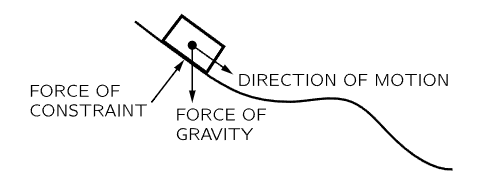
Constrained motion
 المؤلف:
Richard Feynman, Robert Leighton and Matthew Sands
المؤلف:
Richard Feynman, Robert Leighton and Matthew Sands
 المصدر:
The Feynman Lectures on Physics
المصدر:
The Feynman Lectures on Physics
 الجزء والصفحة:
Volume I, Chapter 14
الجزء والصفحة:
Volume I, Chapter 14
 2024-02-14
2024-02-14
 1578
1578
Another interesting feature of forces and work is this: suppose that we have a sloping or a curved track, and a particle that must move along the track, but without friction. Or we may have a pendulum with a string and a weight; the string constrains the weight to move in a circle about the pivot point. The pivot point may be changed by having the string hit a peg, so that the path of the weight is along two circles of different radii. These are examples of what we call fixed, frictionless constraints.
In motion with a fixed frictionless constraint, no work is done by the constraint because the forces of constraint are always at right angles to the motion. By the “forces of constraint” we mean those forces which are applied to the object directly by the constraint itself—the contact force with the track, or the tension in the string.
The forces involved in the motion of a particle on a slope moving under the influence of gravity are quite complicated, since there is a constraint force, a gravitational force, and so on. However, if we base our calculation of the motion on conservation of energy and the gravitational force alone, we get the right result. This seems rather strange, because it is not strictly the right way to do it—we should use the resultant force. Nevertheless, the work done by the gravitational force alone will turn out to be the change in the kinetic energy, because the work done by the constraint part of the force is zero (Fig. 14–1).

Fig. 14–1. Forces acting on a sliding body (no friction).
The important feature here is that if a force can be analyzed as the sum of two or more “pieces” then the work done by the resultant force in going along a certain curve is the sum of the works done by the various “component” forces into which the force is analyzed. Thus, if we analyze the force as being the vector sum of several effects, gravitational plus constraint forces, etc., or the x–component of all forces and the y–component of all forces, or any other way that we wish to split it up, then the work done by the net force is equal to the sum of the works done by all the parts into which we have divided the force in making the analysis.
 الاكثر قراءة في الميكانيك
الاكثر قراءة في الميكانيك
 اخر الاخبار
اخر الاخبار
اخبار العتبة العباسية المقدسة


